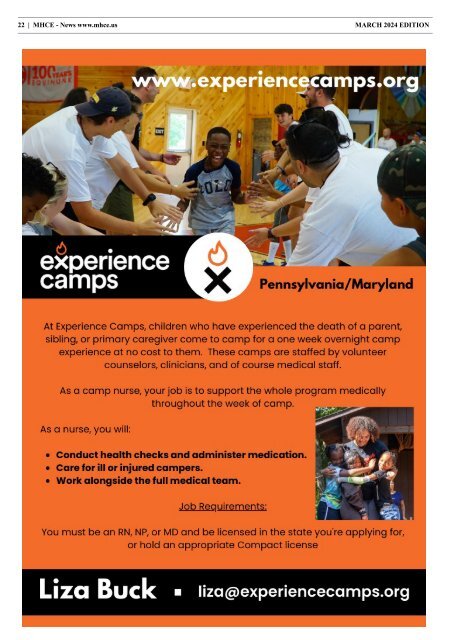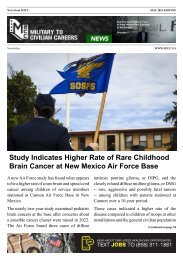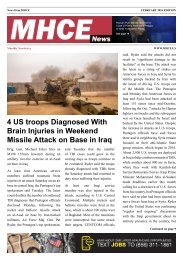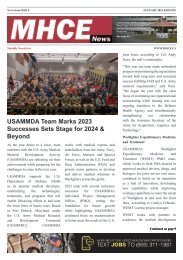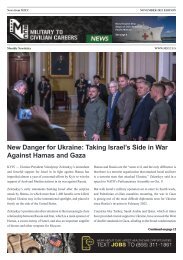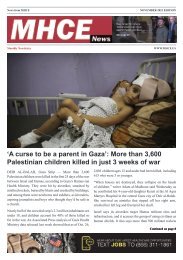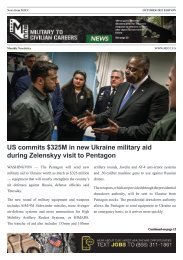MHCE MARCH 2024
You also want an ePaper? Increase the reach of your titles
YUMPU automatically turns print PDFs into web optimized ePapers that Google loves.
22 | <strong>MHCE</strong> - News www.mhce.us <strong>MARCH</strong> <strong>2024</strong> EDITION WWW.<strong>MHCE</strong>.US<br />
Monthly Newsletter | 23<br />
they’ve gotten the chance to do<br />
many different procedures.”<br />
The GHE was a predecessor to<br />
potential upcoming missions,<br />
in which military medical<br />
personnel would maintain<br />
skillsets related to trauma care<br />
and prolonged care in resource<br />
limited environments.<br />
Expeditionary Medical<br />
Unit’s Honduras Mission<br />
SAN PEDRO SULA, Honduras<br />
– Expeditionary Medical Unit<br />
(EMU) 10 G-Rotation 16<br />
strengthened health capability<br />
and expanded U.S. Navy<br />
readiness with Honduran<br />
medical professionals during<br />
a Global Health Engagement<br />
(GHE) in San Pedro Sula, Feb.<br />
17 – March 2, <strong>2024</strong>.<br />
According to U.S. Navy Capt.<br />
Jamie Fitch, the officer-incharge<br />
for EMU 10 G-R16, her<br />
team cared for multiple trauma<br />
patients daily during the twoweek<br />
medical mission.<br />
“Working in a global health<br />
engagement environment has<br />
allowed my team to come<br />
together,” said Fitch. “They’ve<br />
gotten to know each other,<br />
learn each other’s strengths and<br />
weaknesses to some extent, and<br />
how to work through challenging<br />
circumstances together.”<br />
While working in Hospital<br />
Nacional Mario Catarino Rivas,<br />
Sailors from Expeditionary<br />
Medical Facility Kilo and<br />
Navy Medicine Readiness<br />
and Training Command<br />
Camp Lejeune assisted in<br />
the emergency room and the<br />
operating room, allowing many<br />
of them to work together for the<br />
first time.<br />
“The Sailors have seen around<br />
30 to 40 patients,” said Dr.<br />
Guillermo Saenz, a medical<br />
officer and foreign service<br />
national with Joint Task Force<br />
Bravo. “During their time here,<br />
According to Fitch, her team<br />
observed pathology they may not<br />
normally see in America due to<br />
monetary limitations for injury<br />
care. Patients were brought in<br />
immediately after a traumatic<br />
injury or, sometimes, days or<br />
weeks later. These differences<br />
showed Sailors how trauma<br />
care results can vary depending<br />
upon the environment.<br />
“For this mission we brought our<br />
emergency room resuscitative<br />
team and our surgical team<br />
together to see and resuscitate<br />
critically injured patients,”<br />
explained Fitch. “We worked<br />
through the full scope of trauma<br />
care, from the patient’s arrival<br />
to the hospital, through the<br />
operating room, and then on to<br />
an intensive care unit or a ward.<br />
Our expectation was that we<br />
would see patients, and we’d run<br />
them through the full gambit,<br />
partnering with the Hondurans,<br />
doing the full scope of care.”


